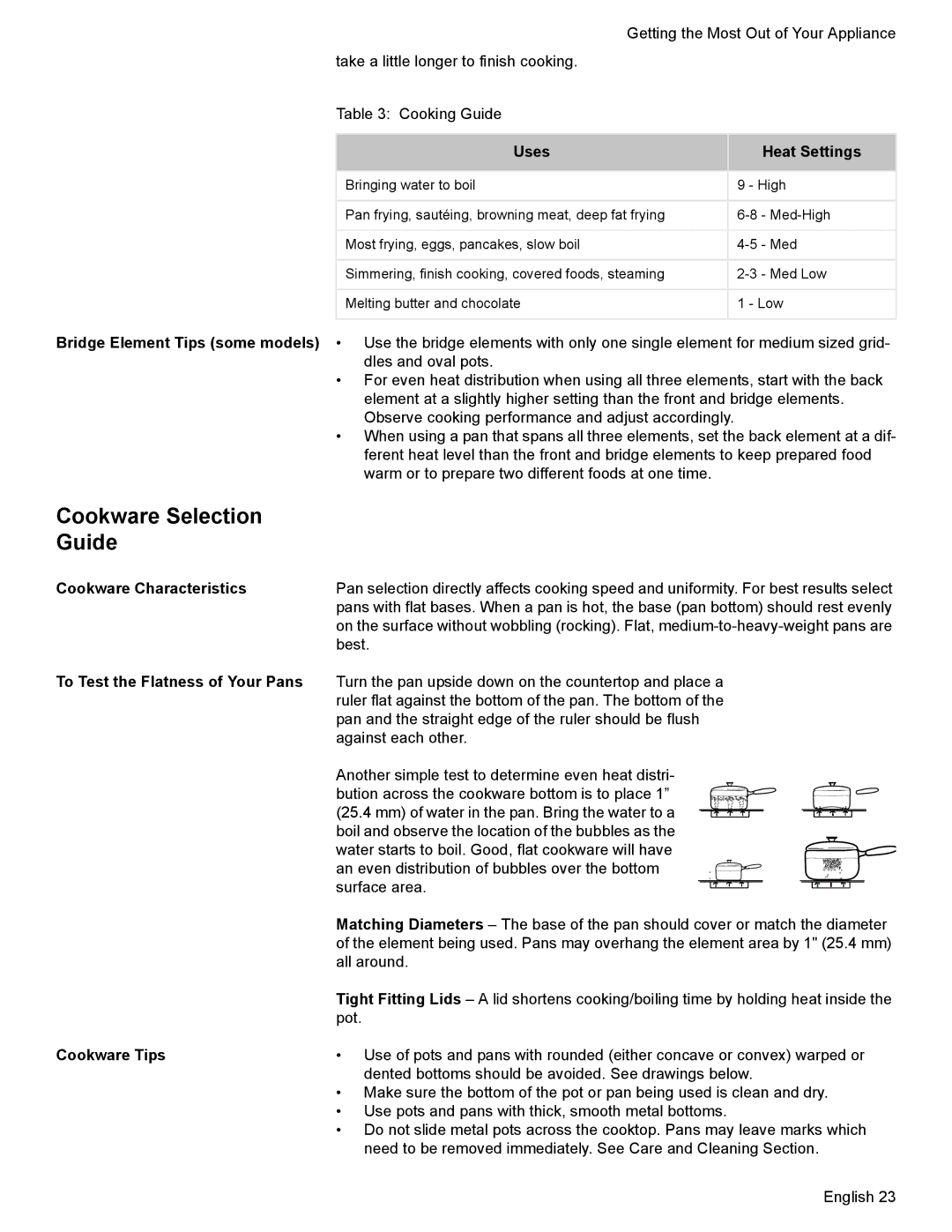
Getting the Most Out of Your Appliance
take a little longer to finish cooking.
Table 3: Cooking Guide
Uses |
| Heat Settings |
|
| |
Bringing water to boil | 9 - High | |
|
| |
Pan frying, sautéing, browning meat, deep fat frying | ||
|
|
|
Most frying, eggs, pancakes, slow boil | - Med | |
|
|
|
Simmering, finish cooking, covered foods, steaming | - Med Low | |
|
| |
Melting butter and chocolate | 1 - Low | |
|
|
|
Bridge Element Tips (some models) • Use the bridge elements with only one single element for medium sized grid- dles and oval pots.
• For even heat distribution when using all three elements, start with the back element at a slightly higher setting than the front and bridge elements. Observe cooking performance and adjust accordingly.
• When using a pan that spans all three elements, set the back element at a dif- ferent heat level than the front and bridge elements to keep prepared food warm or to prepare two different foods at one time.
Cookware Selection
Guide
Cookware Characteristics | Pan selection directly affects cooking speed and uniformity. For best results select | ||||||||||||||||||||||
| pans with flat bases. When a pan is hot, the base (pan bottom) should rest evenly | ||||||||||||||||||||||
| on the surface without wobbling (rocking). Flat, | ||||||||||||||||||||||
| best. | ||||||||||||||||||||||
To Test the Flatness of Your Pans | Turn the pan upside down on the countertop and place a | ||||||||||||||||||||||
| ruler flat against the bottom of the pan. The bottom of the | ||||||||||||||||||||||
| pan and the straight edge of the ruler should be flush | ||||||||||||||||||||||
| against each other. | ||||||||||||||||||||||
| Another simple test to determine even heat distri- | ||||||||||||||||||||||
| bution across the cookware bottom is to place 1” |
|
|
|
|
|
|
|
|
|
|
|
|
|
|
|
|
|
|
| |||
|
|
| |||||||||||||||||||||
| (25.4 mm) of water in the pan. Bring the water to a |
|
|
|
|
|
|
|
|
|
|
|
|
|
|
|
|
|
|
|
|
| |
|
|
|
|
|
|
|
|
|
|
|
|
|
|
|
|
|
|
|
|
|
| ||
|
|
|
|
|
|
|
|
|
|
|
|
|
|
|
|
|
|
|
|
|
| ||
| boil and observe the location of the bubbles as the | ||||||||||||||||||||||
| water starts to boil. Good, flat cookware will have |
|
|
|
|
|
| ||||||||||||||||
|
|
| |||||||||||||||||||||
| an even distribution of bubbles over the bottom |
|
|
|
|
|
|
|
|
|
|
|
|
|
|
|
|
| |||||
|
| ||||||||||||||||||||||
| surface area. |
|
|
|
|
|
|
|
|
|
|
|
|
|
|
|
|
|
|
|
| ||
|
|
|
|
|
|
|
|
|
|
|
|
|
|
|
|
|
|
|
|
|
|
| |
|
|
|
|
|
|
|
|
|
|
|
|
|
|
|
|
|
|
|
|
|
|
| |
| Matching Diameters – The base of the pan should cover or match the diameter | ||||||||||||||||||||||
| of the element being used. Pans may overhang the element area by 1" (25.4 mm) | ||||||||||||||||||||||
| all around. | ||||||||||||||||||||||
| Tight Fitting Lids – A lid shortens cooking/boiling time by holding heat inside the | ||||||||||||||||||||||
| pot. | ||||||||||||||||||||||
Cookware Tips | • Use of pots and pans with rounded (either concave or convex) warped or | ||||||||||||||||||||||
| dented bottoms should be avoided. See drawings below. | ||||||||||||||||||||||
| • Make sure the bottom of the pot or pan being used is clean and dry. | ||||||||||||||||||||||
| • Use pots and pans with thick, smooth metal bottoms. | ||||||||||||||||||||||
| • Do not slide metal pots across the cooktop. Pans may leave marks which | ||||||||||||||||||||||
| need to be removed immediately. See Care and Cleaning Section. | ||||||||||||||||||||||
English 23
